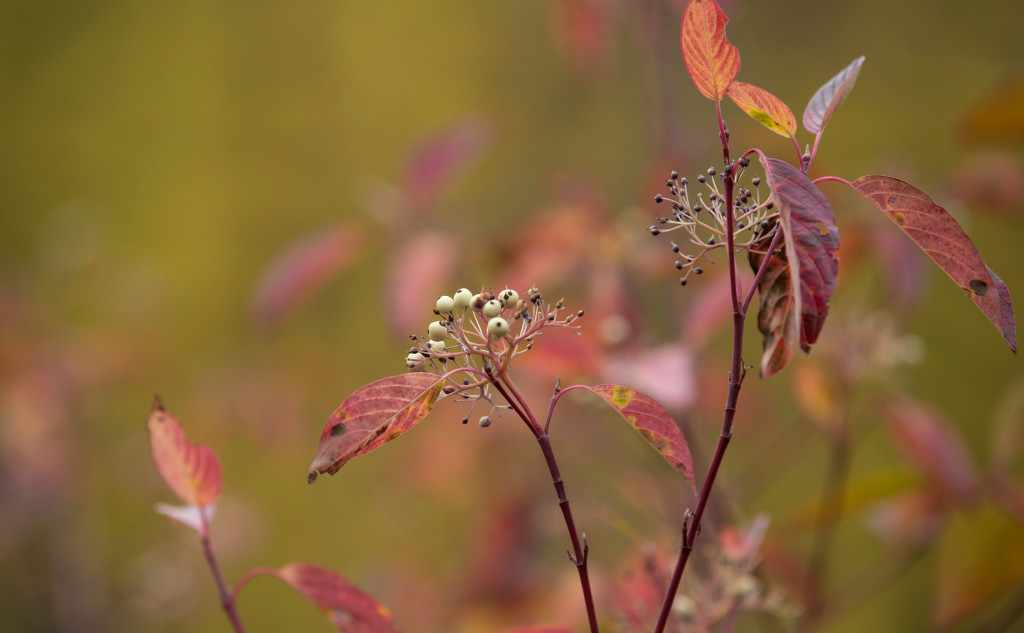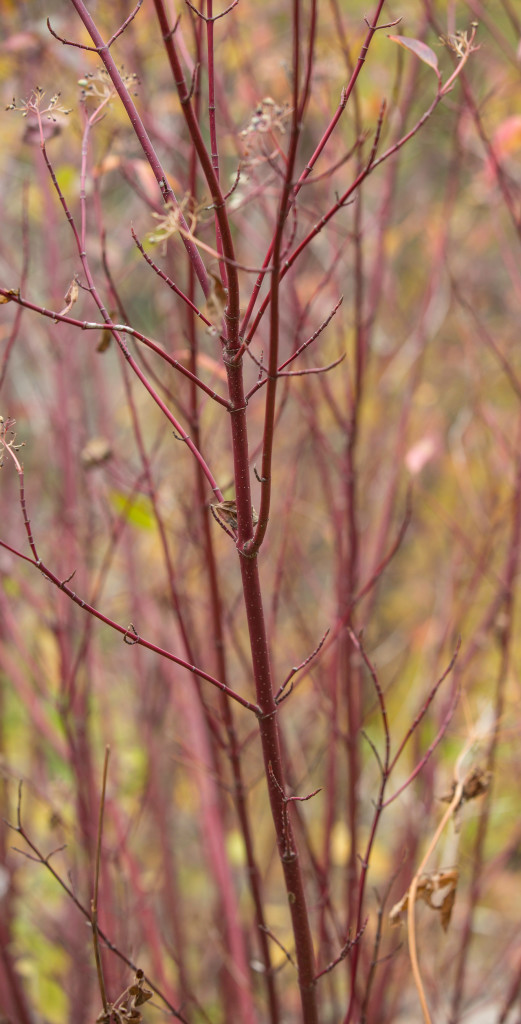
Red-twig dogwood is one of those multitalented shrubs that grows in a variety of moist habitats, provides significant wildlife habitat, and keeps us enthralled year round. Also known as red osier dogwood and creek dogwood (among other common names), it is a multi-stemmed, deciduous, long-lived and fairly fast-growing shrub that develops into an open, somewhat rounded thicket. Its common name comes from signature reddish stems which become brightest in winter. Botanically speaking, it’s known as Cornus sericea (syn. Cornus stolonifera). Sericea comes from the Latin “sericatus,” which means “silky” and describes the soft texture of the leaves and young twigs. Stolonifera refers to its lower stems or branches that tend to tiptoe horizontally and grow roots when they touch the soil.
Besides its vibrant red stems, this plant has oppositely-arranged, deep green leaves that turn an array of colors as the days shorten in autumn. On this sunless late November day in my back yard, the leaves range from a soft gold and pale orange to deep red, and they’re becoming more purplish-red each day. Come spring, four-petaled creamy white flowers will appear in clusters in May to July and will be tailed several months later by soft white to pale blue fruit (shown above) that may persist into winter if the birds don’t devour them.

How it grows
Red-twig dogwood has a large range—from Alaska and northern Canada from coast to coast, and as far south as Virginia in the east and Chihuahua, Mexico in the west, at low to middle elevations. There are two subspecies: C. sericea ssp. occidentalis, which occurs in the Pacific Northwest, Alaska, California and British Columbia, and C. sericea ssp. sericea, which is found much more widely. Differences are miminal, with the latter having slightly larger flower petals and fuzzier leaves and shoots. Both typically occur in moist, open sites such as meadows, bogs, floodplains, and near shorelines, but they also can be found under forest canopy as well as within more open woodlands in or near riparian areas.
Wildlife value
Red-twig dogwood is important for providing diverse structure, cover, nesting habitat, and a variety of edibles for insects, mammals, amphibians, and a large number of bird species. Bees and other pollinators, such as butterflies, use the flowers for nectar and/or pollen. Birds (including waxwings, thrushes, band-tailed pigeons, northern flickers, and grosbeaks), small mammals, and bears dine on its fruits—one or two-seeded drupes which are reportedly very high in fat—in summer and fall. According to the US Forest Service, “moose, elk, deer, bighorn sheep, mountain goats, beavers, and rabbits” commonly browse the stems; twigs and new shoots provide especially delectable and nutritious winter browse. Last, but not least, this shrub provides cover and important nesting habitat for songbirds, small mammals and amphibians, as well as host plants for the larvae of butterflies like the echo blue butterfly.
 Try it at home
Try it at home
Although fairly shade tolerant, plants growing in full sun typically grow much more compactly than those in shade, usually bloom more profusely, and exhibit more stem color. Depending on the amount of sun it receives, red-twig dogwood can grow from about 6 to 16 feet tall, and nearly as wide, so it may be best to leave it out of very small gardens. If you have the space, use it in any moist area where you’d like spectacular aesthetic appeal as well as valuable wildlife habitat: At the back of a border, next to a rain garden, as a somewhat open screen, as part of a large hedgerow, or to stabilize eroding soil on slopes. Plant it in the fall to give it an easy start in life, adding some leaf compost if your soil is in poor shape. Allow future leaves to stay where they fall.
Damp soil is important, and slow-draining soil is not a problem (although this plant shouldn’t have its feet immersed in water for prolonged periods). Though its tolerance for drought isn’t terribly high, with a little shade and soil that’s rich in organic matter, infrequent summer watering during excessively hot periods should be all that is needed once it’s established (typically just a couple of years). And, allowing for a dry period at the end of summer is actually a good and natural thing (as long as the plant looks healthy), since a bit of drought prepares the plant for winter. Red-twig dogwood is often planted at restoration sites, which are rarely watered afterwards, and most usually do fine.
Grab a partner
Since red-twig dogwood grows in such a wide range of habitats, there are a number of plant friends with which it would like to live. For best ecological and gardening results, choose associated native plants that live in communities that currently grow or likely would have grown in your immediate area. In the Pacific Northwest, some of the plants that closely associate with red-twig dogwood include western redcedar (Thuja plicata), Douglas-fir (Pseudotsuga menziesii), vine maple (Acer circinatum), alder (Alnus spp.), willow (Salix spp.), aspen (Populus tremuloides), paper birch (Betula papyrifera), gooseberries (Ribes spp.), black hawthorn (Crataegus douglasii), lupine (Lupinus spp.), aster (Symphyotrichum spp.), and many others.
To leave a comment, click on post’s title
Can these be houseplants? I’m asking because our Christmas decoration started growing roots and leaves in the water filled vase they were in. If so, at at what point would we put them into soil? They’re a beautiful center piece and remind me of an orchid
I doubt they’d last very long in a pot (unless it’s huge) since their roots need a lot of space and the plants need sun and seasonal change, but you could try if they have roots. If you want to plant them outdoors I’d suggest acclimating them slowly, to get them used to the colder temps outdoors.
I have a red twig dogwood that came up volunteer in my native habitat. It’s within 6′ of an Oregon Ash and a young Oak. Also nearby is a Japanese Maple. It’s popped up in the middle of my wildflower planting – Yarrow, Oregon Sunshine, penstemon, beach daisies, Idaho fescue. I’m concerned about it taking over all of the existing plants, and being so close to my trees; yet I appreciate its overall habitat value. Trying to assess if I should take it out or leave it? If I left it, I would need to keep it reined in by pruning. Would I negate it’s value by doing this?
I really can’t comment fully without seeing the site, but in general, it will be the ash and oak trees that will eventually shade your sun-loving perennials. The ash alone will get to 3 to 4 times the size of a red-twig dogwood, and provide much more shade. You can cut back the latter, but it will provide a nice thicket without pruning. See pages 104-05 in my book about the dynamic nature of landscapes/gardens.
We have a natural wild thicket red-twig dogwood. A bit too twiggy perhaps, and lots of ground crawlers. Any suggestion for helpful pruning? Decent light exposure along with natural spring feed soil. About 4 meters by 10.
Have observed for bird nesting, non present ;-). Appreciate your thoughtful commentary on all the garden inhabitants!
Thanks for your comment and for growing natives, William. If you are gardening for wildlife, I don’t recommend pruning. Frequent pruning compromises the health of most plants and may deprive them of their wildlife appeal. However, for ornamental purposes, you can cut about 1/3 of your shrubs’ branches to the base every few years to remove the oldest branches to renew color and stimulate new branching. I’m not sure what you mean by “spring feed soil” … these plants don’t need fertilizer but like organic matter, such as fallen leaves that are allowed to remain on the soil.
I received a red osier dogwood as a “thank you” for volunteering @ City of Vancouver. Thanks for the tips on where to plant and the friends with whom it likes to share its space!
You’re very welcome, Kathy … I’m glad the post was of help. What a nice gift to receive! I hope you will enjoy it for many years.
I missed the fall planting window. It’s december but not yet freezing. Am I too late; or is early spring an option?
Planting now should be fine, although if it’s raining a lot right now you might want to wait until there’s a bit of a dry spell (if you have a lot to plant, consider placing a board down where you’ll be standing to try not to compact the wet soil too much). Enjoy!
Hi! I have a typically sized backyard garden in the NE of Portland. It’s far too small for an actual thicket of red-twigged dogwood, but I would love the winter color and to provide the berries for the birds. What do you think of planting these in containers and cutting old growth every year or so (once established) to keep the size down?
In containers they would eventually get root bound and die. You could instead cut back branches that touch the ground and remove suckers as you see them to slow down the plant’s growth, but it may not be the best plant for your situation. That said, a sunny spot may keep them a bit smaller. Thanks for growing natives!
Thank you so much for the response. I’m not sure what I will do yet, but I keep “seeing” the dogwood back there, so I may experiment. If I do, I’ll update you with the results. Thanks again, your advice is really helpful.
does it provide photosynthesis year around in Portland?
No it doesn’t, since deciduous plants drop their leaves each autumn. But their photosynthetic ability (to capture carbon and convert it into chemical energy) is greater than that of coniferous plants that generally have longer-lived leaves. Growing a diversity of species that are found in a particular region—both deciduous and coniferous—is important. This article and its references provide more info: https://www.wnps.org/blog/conifers-deciduous-trees/. Thanks for your question.